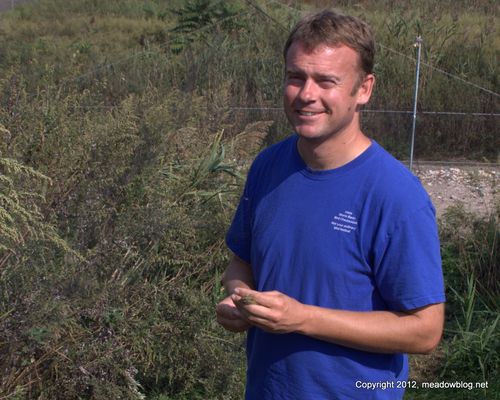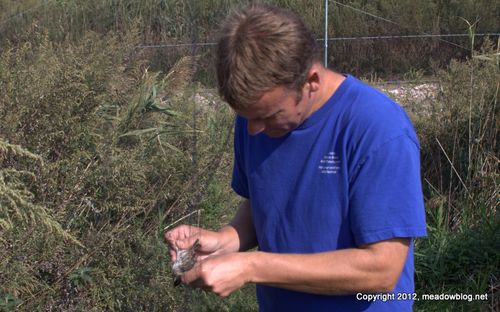
Jim Wright, who maintains this blog for the Meadowlands Commission, also writes a twice monthly "Nature Next Door" column for The South Bergenite. Here is Jim's latest — an interview with NJMC Naturalist Mike Newhouse (above) about Mike's bird-banding project.
With autumn upon us, we’re getting a change in winged visitors in the Meadowlands. The shorebird migration is winding down, the raptor migration is in full swing, and some ducks typically associated with the colder months are already arriving.
To get the latest low-down on the avian comings-and-goings along this portion of the Atlantic Flyway, we checked in with N.J. Meadowlands Commission naturalist Mike Newhouse, who has been doing his autumn bird-banding research for the fifth year in a row in North Arlington.
NJMC: What’s the most striking thing you’ve seen so far this season?
Newhouse: Some birds are starting to migrate a little early this fall. For example; last year we saw our first palm warbler on Sept. 12, but this year we had them as early as Sept. 5. Also, northern shovelers are coming in already. Most ducks don’t starting showing up in good numbers until October, but as of Sept. 17 we have seen flocks of 70 shovelers or more.

Mike removes a bird from a mist net so its information can be recorded and it can be banded and released.
NJMC: Any surprises or rarities in the past few weeks? How so?
Newhouse: Earlier in September we had a Baird’s sandpiper that showed up near DeKorte Park. Recently, we have also had a few dickcissels come through over Harrier Meadow. We were hoping to see a few dickcissels this year as there was a movement eastward of breeding birds this summer as the central plains were very dry and they had to expand looking for new territories.
NJMC: How is the bird-banding going?
Newhouse: Really well. We are on pace to have our best September yet, both with the diversity of species and abundance. We have caught a few rare birds such as Connecticut warbler, saltmarsh sparrow, and several yellow-bellied flycatchers.
NJMC: What have you learned from your research thus far?
Newhouse: We have learned that birds are using the Meadowlands landfills and marshes as a stopover site during migration. Some people think that the Meadowlands may be an ecological trap — a habitat attracting birds but with no benefit to them — but we have found out that birds using the Meadowlands as a stopover site are gaining the proper weight to continue their migration.
This long-term study has helped us learn more about population fluctuations of several species and also about how important these habitats are to threatened and endangered species in New Jersey. We have caught several species that are either threatened, endangered, or special concern – including Bobolink, Grasshopper Sparrow, Vesper Sparrow, Northern Harrier, Sharp-shinned Hawk, and American Kestrel.
NJMC: What birds should be showing up in the next few weeks?
Newhouse: Keep your eyes open because we are about to see an abundance of sparrows, yellow-rumped warblers, and several duck species. The peak of fall migration is about to begin, so anything may show up.

Gee, do you think this could mean an early cold winter.
WOO HOO Jim Wright- You are famous. Great story on Channel 4 just now and you are very handsome.
cool
That is really nice Jim.
By the way, I am a bird ringer too, could you pls kindly give me Mike Newhouse` email address? we can talk more on the same interest—bird ringing